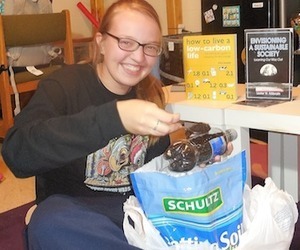Implementing Environmental Education in South Bend Schools
- Student
- Dayna Smith
- College(s)
- College of Science
- Faculty Advisor
- Stuart Jones
- Class Year
- 2014

Objective
To easily implement sustainability education into the classroom by designing lessons around accessible topics.
Why Focus on Education?
Education is often viewed as one of the most vital components in making societal changes that will lead to a more environmentally friendly future. It has been found that one of the main issues combating change is how institutions are organized; this means that an institution with goals concerning sustainability education that are implemented is more likely to convey the need for change to their students (Stephens et. al 2008). The same relationship would exist in elementary education, catalyzing change in young minds. Most environmental education programs are currently focused on the university level.
Additionally, I realized I didn’t have any environmental education in primary or secondary school. I found my environmental education in outside programs. Therefore, I wanted to make sure children were exposed to topics in sustainability.
Why South Bend?
The South Bend Community School District (SBCSD) recently developed a committee to address the lack of sustainability education and practices within the district. Therefore, they were receptive to accepting lesson plans concerning topics in sustainability for use in everyday classrooms, as well as in educational enrichment programs. The district also recently developed an environmental magnet school, which could also utilize my lessons.
The Topics
Four topics that are accessible to younger (1st-3rd grade) and older (6th-8th grade) students.
- Biodiversity
- Energy
- Waste
- Water
These topics were picked with the intent that students could see and act upon their lessons in everyday life. For example, a student learning about energy conservation in school can go home, recognize energy being wasted by a light being on in an empty room, and turn off the light.
The Lesson Plans
Lessons are complete for the teacher and may include an outline, PowerPoint presentation, background reading, and/or activity.
- 1st-3rd Grade
- Biodiversity: Endangered species
- Energy: Conservation
- Waste: How long does trash last?
- Water: Basic water cycle and conservation
- 6th-8th Grade
- Biodiversity: Aquatic invasive species
- Energy: Calculating energy costs
- Waste: Recycling
- Water: Where does my water come from?
Where Will the Project Go?
- Environmental Magnet School: the SBCSD recently started a school focused on teaching inner-city children about the environment and sustainable living. Since my lessons are tailored to such topics, they may be able to be used in this school.
- Enrichment Classes: the SBCSD identifies advanced children and teach them additional lessons every week. However, staff members sometimes struggle to create new lessons for the kids. My lessons will make it easier on the staff to teach the advanced kids new and exciting topics.
- Normal Classes: when SBCSD teachers are ahead on planned lessons, my lessons could be used as a “filler day” because they are all able to stand alone in one class period.
Additional Information (Sources)